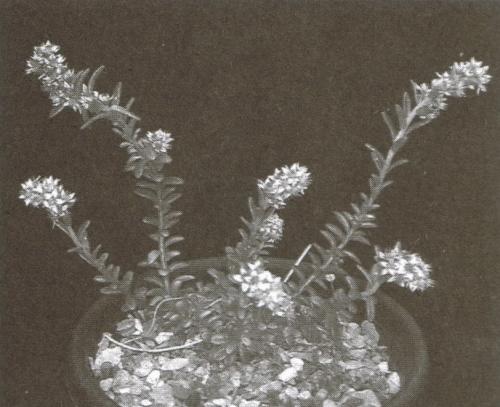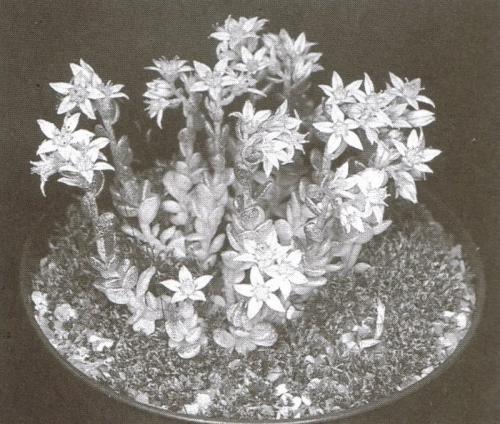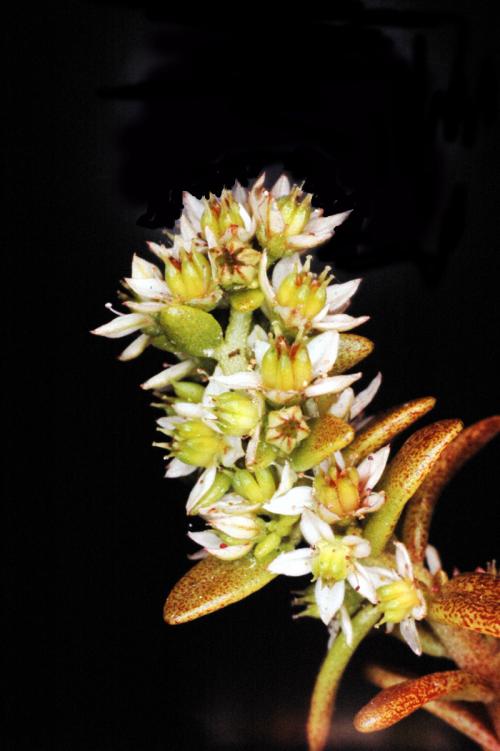MAGELLENSE Tenore, 1811
Synonyms :
Oreosedum magellense (Tenore) Grulich (1984)
Sedum olympicum Boissier (1843) / Sedum magellense var. olympicum (Boissier) Fröderström (1932) / Sedum magellense ssp. olympicum (Boissier) Greuter & Burdet (1986)
Sedum brutium N. Terracciano (1891)
Distribution : South-eastern Europe (central Italy, Balkans, Greece including Crete), Turkey (South-western Anatolia); mountains.
Description (according to 't Hart & Bleij in IHSP, 2003) :
Perennial herbs with erect or ascending rooting stems, often forming small tufts, to 5 cm tall.
Leaves opposite or alternate, obovate-oblong or somewhat spatulate, sessile or semipedicellate, obtuse or rounded, flat, spreading, 6 - 10 x 4 - 8 (-10) mm.
Inflorescences : Flowering branches erect, 5 - 15 (rarely to 30) cm, with alternate leaves, inflorescences narrow elongate racemes consisting of a variable number of small, usually few-flowered, rarely forked cincinni, bracts small, lanceolate, pedicels thin, 2 - 5 mm, sometimes sparsely glandular-pubescent.
FIowers 5-merous, sometimes sparsely glandular-pubescent, sepals broadly sessile, basally connate, triangular-oblong, obtuse, ± 1,5 mm, petals basally free, lancelolate, acute, white, ± 4 mm, filaments white, anthers red.
Cytology: 2n = 28, 30.
Plants from the Balkan Peninsula differ from the typical central Italian form in their smaller, broader and more constantly opposite leaves, and have been distinguished either as var. or ssp. olympicum.
Ray Stephenson (Sedum, Cultivated Stonecrops, 1994, pp 140 - 141) :
Sedum magellense ssp. magellense is an unusual and rare species in collections. It is a very distinct little plant having leafy, racemous inflorescences, each with the outline of a cone or cylinder, rising to about 12 cm (5 in). Bright green, flat leaves can turn bright red in full sun, and white flowers are often tinged with purple or green.
Habitat : This south European stonecrop cornes from the Apennines Mountains of Italy (especially Monte Majella), former Yugoslavia, Albania, Bulgaria, Greece, Crete, Asiatic Turkey, and Algeria, often in shade, but as a true alpine.
Main points of distinction : As this species is unlike any others in the group, it is unlikely to be misidentified. Flat, bright green, glabrous leaves without spurs and tall, narrow flower spikes are the best guides. Also carpels, abruptly tipped with a short and broad style, and clearly visible yellow nectary glands help confirm identity.
Variation : Two distinct forms exist : Sedum magellense ssp. magellense from Italy with alternate leaves, and S. magellense ssp. olympicum from Greece and probably elsewhere, which tends to have opposite leaves (Leaf shapes figs. 3cc & 3dd). The type species is an extreme form that has probably evolved from S. magellense ssp. olympicum. It is taller and more open. 2n = 28 and 30. Greek and Yugoslavian plants, often encountered in cultivation, are compact and very low growing. Some leaves turn bright red, a superb contrast to others on the same plant that remain bright green.


Sedum magellense ssp. olympicum in a 2-in (5-cm) pot.
Horticulture : This is a very bright green carpeter. If cultivated in pots, it needs to have its roots under a stone to stop baking in hot summers. I highly recommend it for raised beds and deep troughs. It likes a lot of water in summer.
